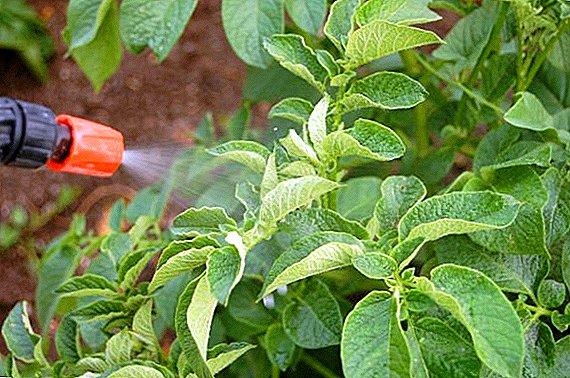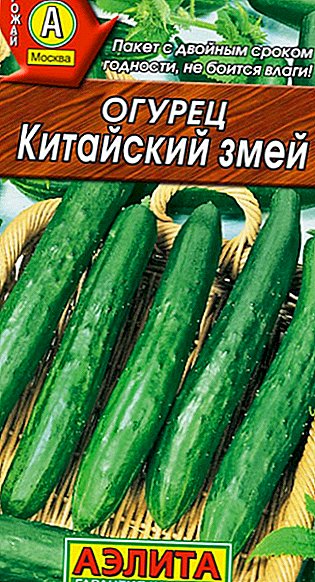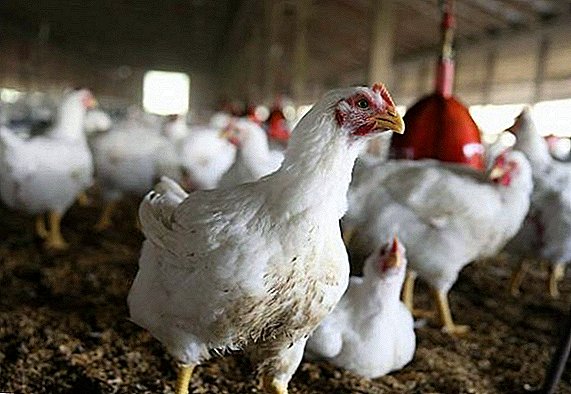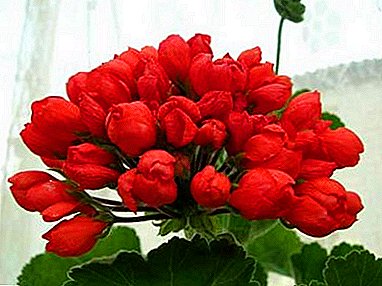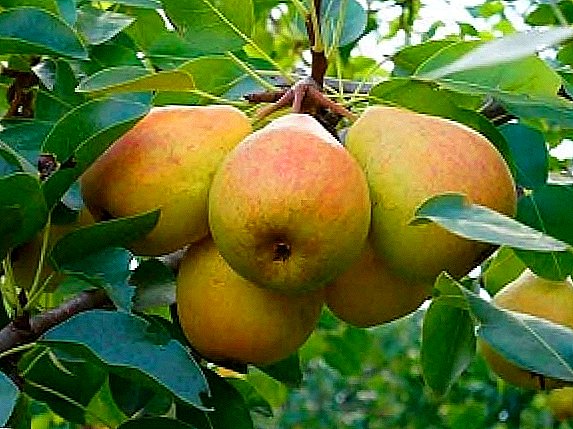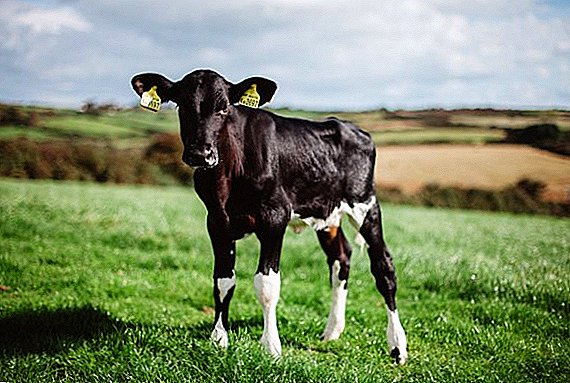 Experienced breeders know that the young need to inspect and observe from the first days of life.
Experienced breeders know that the young need to inspect and observe from the first days of life.
Attentiveness, early care and prevention will help to avoid many serious diseases of the young, for example, rickets.
What kind of ailment this is, how to deal with it will be discussed in this article.
What is this disease
Rickets is an abnormal development of bones, which occurs due to the lack of beneficial elements in the body and impaired metabolism.
Early manifestations of the disease look like some lag in development: thinness, protruding pelvic bones, an unsteady gait, lack of activity.
Important! Even after treatment, the patient must be observed, as the consequences may appear in a few years.
Delay in treatment leads to serious changes in the whole body: due to the deformation and fragility of the bones, the internal organs of the animal can suffer. 
Causes
Since the disease develops with a lack of vitamins and minerals, the unbalanced diet of pregnant cows is in the first place.
Initially, the fetus receives nutrition from the maternal organism. Therefore, nutrition of pregnant females should include a full set of vitamins and minerals, if necessary, use pharmacology.
Familiarize yourself with the treatment of beriberi in cows and calves.The main vitamin, the lack of which results in a serious illness - vitamin D. It is this substance that regulates the exchange of calcium, phosphorus, magnesium, contributes to their healthy accumulation and transportation throughout the body, is involved in the production of protein.
Disturbances in metabolism can lead not only to bone fragility, but also to changes in the brain, circulatory system, digestive tract and cardiac activity.  The main source of vitamin D in calves is the mother’s milk, and in the young and adults, the sun, under the action of ultraviolet, calciferol is formed in the tissues of the animal. The less time animals spend on the open pasture, the less calciferol their body synthesizes.
The main source of vitamin D in calves is the mother’s milk, and in the young and adults, the sun, under the action of ultraviolet, calciferol is formed in the tissues of the animal. The less time animals spend on the open pasture, the less calciferol their body synthesizes.
Did you know? Extraordinary loyalty to the owners was demonstrated by a cow named Julia in the USA. The owners sold it to farmers living over thirty kilometers, but after a few days, Julia showed up at her former place of residence.
Another important factor is considered unsuitable conditions of detention, drafts, dampness, lack of lighting and cold. The freezing inhabitants of the barn will spend more energy on heating the body, to the detriment of the accumulation of useful substances and natural development.

Symptoms (clinical signs)
Visual and behavioral signs of the disease:
- skull deformity;
- thickened joints;
- curvature of the limbs;
- thickening of the endings;
- spinal deformity;
- obvious asymmetry of the whole body;
- non-closure of jaws;
- enlarged sagging belly.
- lethargy;
Learn how to treat diarrhea, hypotrophy, white muscle disease, bronchopneumonia in calves.
- appetite disturbances;
- the calf licks other individuals, drinks urine, licks clay or lime;
- most of the day lies;
- moves with difficulty;
- wobbly gait;
- there is lameness;
- crunching in the joints;
- loose teeth;
- diarrhea;
- shortness of breath with dyspnea.

Clinical signs:
- palpation for the patient is painful, especially in the pelvic region;
- lack of phosphorus and calcium;
- hemoglobin is lowered;
- moderate leukocytosis is observed;
- temperature does not change;
- rapid pulse;
- the medullary canal is expanded;
- reduced tone of smooth and skeletal muscles.
Did you know? Unusual fights are held in Switzerland - the participants are cows, which are divided by weight category. Everything happens strictly according to the rules and without blood (horns are specifically dulled). Fighting for the title of queen, the cows, resting their foreheads, find out who is stronger, fallen three times, or a cow who has evaded fighting is considered to be the loser. The winner receives the title, and its owner - a cash prize.
Diagnostics
For the diagnosis, a visual inspection is carried out with the introduction of the diet and conditions of detention, the patient's palpation.
Next, conduct the following studies:
- blood chemistry;
- X-ray;
- ultrasound echooscopy.

Pathological changes
When dissecting dead animals, the following changes are observed:
- softening of the bones (can be cut with a knife without effort);
- thickening at the ends of the tubular bones;
- traces of numerous fractures;
- cartilage is easily separated from the bone;
- the internal surface of the chest is deformed;
- changes in the respiratory system (presence of exudate in the bronchi, swelling of mucous membranes, traces of hemorrhages);
- the digestive tract organs are deformed, with traces of hemorrhages, darker in color, with the presence of mucus, swollen mucous membrane, the presence of ulcers;
- heart muscle flabby;
- the skin is inelastic.
Find out what causes lethargy and poor appetite for calves.
How and what to treat rickets in calves
Treatment should be comprehensive: review of conditions of detention, diet, use of drugs and procedures.
Conditions of detention
Indoors, a deep bedding is laid on the floor, regularly cleaning a wet or soiled layer. The most popular material is straw, it is ground for the best hygroscopic qualities.
In winter, artificial lighting and heating should be present. If the animal is on a leash, its length should allow free movement in the stall.
Animals should breathe fresh air, therefore, a ventilation system is required. There should also be walks:
- in the summer pasture (free grazing);
- in winter, calves are walking indoors (physical activity should be regular).
Find out what vitamins calves need for rapid growth.
Feeding ration
A pregnant cow should eat foods rich in minerals and vitamins:
- cereals;
- hay or fresh grass;
- mash with vegetables;
- sunflower meal meal;
- special premix for dry cows with potassium iodide, zinc and copper sulphates, cobalt chloride;
- fish fat.

Newborns get everything they need along with colostrum, and within two weeks they are sucked away by mother's milk.
Important! Be sure to have fresh water in large quantities, so that there is no stagnation in the digestive organs.Further, the diet gradually include:
- milk-based milk replacers;
- finely stalked hay moistened with a weak brine;
- oatmeal;
- easily digestible feed;
- bran and cake;
- vegetables (carrots, potatoes, zucchini - sources of vitamin A);
- wood flour;
- chalk and bone meal;
- green food (dandelion, clover, horsetail, alfalfa - sources of vitamin D).

Veterinary drugs
In addition to the correction of the diet and care, young animals are administered drugs that compensate for the lack of vitamins and minerals:
- Trivit (subcutaneously or intramuscularly 1.5-2.0 ml once a week, the course lasts a month);
- Tetravit (2-3 ml subcutaneously or intramuscularly, once a week, for a month);
- Eleovit (intramuscularly in the thigh or neck, the solution is heated before administration, the dosage is 2-3 ml, every eight days).
Find out what to look for when buying a calf, what to call a calf.
Prevention
To prevent rickets, farmers perform a series of measures:
- Vitamin preparation Tetravit in a dosage of 5-6 ml is administered to dry cows about a month before calving.
- Veterinary control and routine examinations of animals are carried out, and newborns take blood for analysis.
- Adults and young animals regularly walk.
- In winter, they use UV irradiation.
- For the prevention of the herd give vitamin and mineral supplements.
- Monitor the purity and temperature in the barn.



